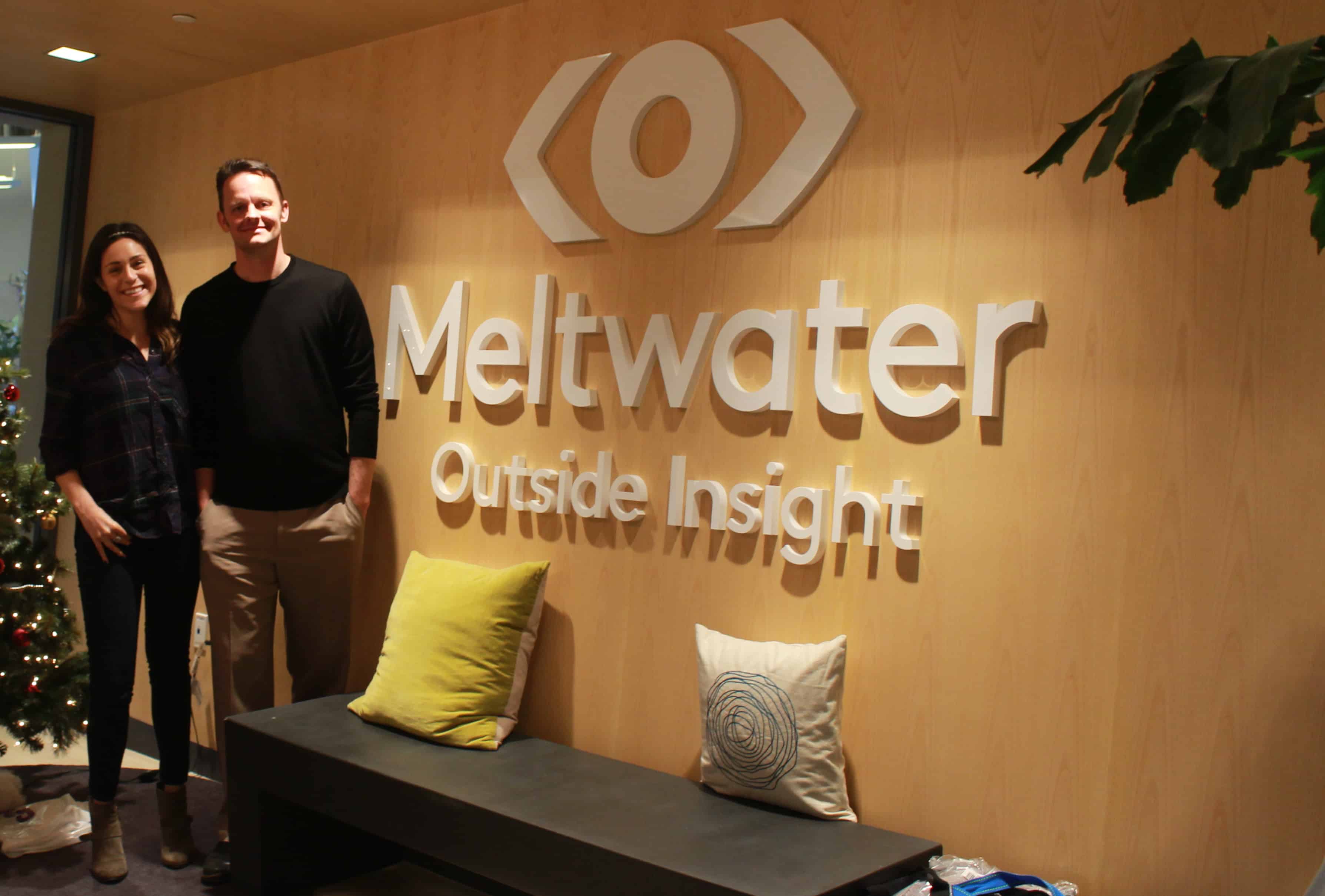Outside Insight: Navigating a World Drowning in Data.
Meltwater CEO, Jorn Lyseggen makes a case for his new book, Outside Insight, by analyzing a world that is “drowning” in data. Jorn claims that the data that is scattered online can weave a fascinating story. The author refers to data as “digital breadcrumbs” that we leave behind in the course of our browsing the internet. By simply following this trail of “digital breadcrumbs” and piecing them together, the puzzle offers rare insights into businesses and how to conduct them.
Lyseggen observes that the internet has changed how we live and make decisions but the managers’ decision-making process has not had significant changes in a majority of the organizations. Today, the managers and other stakeholders tasked with decision-making mostly focus on internal data like stocks, sales figures, etc despite this data being only half the truth.
Outside the company’s four walls lies a huge amount of data. An example of these digital breadcrumbs includes the press releases from key industry players which may affect your business as well as reviews left by customers in social media channels. Another dataset to watch out for is the recruitment patterns of your competitor in a particular region.
If you understand what happens outside your company’s four walls immediately it occurs, you can make informed business decisions to help you stay ahead of the pack.
“Outside Insight shifts the focus from internal data and what you are doing to external data and what your industry is doing, allowing you to benchmark against competition and discover new threats and opportunities in real time,” Lyseggen writes.
Lyseggen’s new decision-making methodology is cut from a different piece of cloth and speaks to the core of executive responsibilities – beyond communications and marketing. Everyone in the decision-making chain can invaluably gain from employing this methodology.
This understanding of external data is what Jorn Lyseggen calls “Outside Insight”. The book emphasizes on the need to shift focus from internal data to external data analysis, which includes online data sources. An analysis of both of these datasets leaves a company with a fairer picture of reality. This way, the company is able to paint an overall picture of the outside world thereby identifying both threats and opportunities.
This book’s strong credibility element stems from Lyeseggen’s combination of a great story-telling ability and his entrepreneurial journey. Way back in 2001, Jorn Lyeseggen predicted that big data would in future become a tool to develop competitive intelligence. He then founded Meltwater to harvest external information which would in turn be used to in the decision-making process.
In 2001, when he cofounded his firm, Lyeseggen did not anticipate the rise of social media. “Today smart algorithms, natural language processing (NLP), machine learning and big-data techniques are used to create analytics and insights from online news and social media that we would not have dreamed of back in 2001”.
Jorn Lyeseggen’s career began at the Norwegian Computing Centre as a research artificial intelligence scientist where he added several patents to his credit. The author is also an active philanthropist and he founded the Meltwater Entrepreneurial School of Technology (MEST), in 2008. MEST is a tertiary institution for training and developing African software and tech entrepreneurs and also sponsors a network of pan-African tech incubators spanning Ghana, Nigeria, Kenya and South Africa.
Outside Insight shows that big data is getting bigger. However, the underlying challenge is that we are not sufficiently equipped to handle and deal with its enormity and fast evolving landscape. The Panama Papers Scandal exposed the challenges and the need to collaborate with data to build meaningful insights.
The book has 17 chapters that cover four broad sections:
Rapid strides in new data types and its mining
Lyeseggen uses case studies to illustrate strides in big data such as the “Rise and Fall of Blackberry,” “Tracking the indiscretions of LinkedIn connections,” and “Tales from Company’s websites.”
With these case studies, the author sets momentum for this book by highlighting the fact that companies need to look for external data to gain competitive advantage. He stresses that a conservative approach and looking out for insights using internal data is likely to lead to lagging insights.
A myriad of external sources could give you insight about your future transactions more than your present internal sources. He argues that an organization relying on internal data alone could suffer from internal bias, follow a subjective narrative and lose out on making strategic decisions.
Accessing real-time information related to industry-specific changes
The next section shows us how to look into the future by leveraging on the aid of external data. Making decisions especially about the future can be a big blind spot for corporate decision makers. The author goes ahead to explain the value of external data in terms of Benchmarking and Real Time with the aid of case studies.
The concept of benchmarking and real-time data introduces a new way of thinking and a digital paradigm. This is very strong and shows the overall premise that the industry faces as traditionally people first look at what is happening internally before shifting focus to what is happening outside.
While we have witnessed the concept of external data, real-time data and benchmarking presented in other circumstances, never before have we seen them working together than in this book. Separate chapters in the book uses current cases to illustrate the harmony of this methodology in action especially in the case of how USPS and Minute Maid approached this concept.
Practical examples to help readers in Decision-Making
This section of Outside Insight addresses various stakeholders and management aspects to take into consideration. It further outlines how to incorporate the insights that we gain from data into executive decision-making, product development, marketing, risk and investment decisions.
It uses relevant cases to help us understand the importance of data and its application. Chapter 9 which talks about Outside Insight for Marketers is very march relevant for digital marketers in the social media space as well as trainers in strategy. In the chapter, Lyseggen makes the following points:
Chapter 11, that deals with Outside Insight for Risk Management, is very relevant to anyone who is interested in crisis and risk. The section emphasizes the need to have all the tools, plans and metrics structures put in place before the occurrence of an incident and then we are able to evaluate and act on such insights in real-time. This is a key specialization and focus area for social media.
The book uses a wealth of clear examples to put things into context. An example of case studies that is presented in the book is the story of Kodak. It talks of how Kodak really could not see what was going on outside of their company with respect to camera sales. The author points out that had Kodak looked at external data, they would have noticed that the camera industry was experiencing a major shift that ultimately would impact their brand position.
Conversely in the same chapter, the author talks about Instagram, and how the brand looked at and reacted accordingly to what the data was saying about the industry.
Arising technical obstacles and how to solve them
In cognizance of the fact that big data is continuously evolving, this section looks at these obstacles and challenges and how we can solve them. The author reckons that big data continues to have immense potential and subsequently problems keep arising. The consequence is that business needs have to keep changing as one foresees potential challenges and concerns.
One of the things that I found particularly strong about this book is that it not only identifies areas to watch out for in the future but also the potential risks that may come with this new paradigm approach. The book also turns the heat on privacy, Algorithm changes, fake influence, fake news and buying social media likes.
These four broad sections raise important issues of how businesses ought to utilize the media – including social media, to pursue their agenda and manage their reputation and brand image. The cases used by the author are weighty and educators could as well find them useful in the classroom.
Chapter Six of the book emphasizes the “Value of Real Time” which discusses the relief and rescue efforts in the wake of natural calamities like earthquakes. The section emphasizes the value of the rescue teams to utilize available data to hasten relief efforts.
Lyseggen cites the case of the 2011 Manchester riots where the Greater Manchester Police used real-time social media monitoring to manage and contain the riots. This was a first in the history of the British police and serves as an effective case to demonstrate the concept of ‘outside insight’.
“Careful monitoring of social media channels to locate looters, source damaged locations and intercept organized activity by riot groups enabled the police to coordinate arrests. . . they monitored Facebook, Twitter, Flickr and YouTube for vital clues and intelligence”, writes Lyseggen. (p. 95).
Traditional journalists seem to have perfected this art on the social media platforms like Twitter and Facebook where they follow official accounts of celebrities, CEOs and law-enforcing agencies searching for voices of authority to enhance the credibility of their sources.
Reputation management and crisis communication is often a headache for corporate communication team. This is therefore, another sphere that ‘Outside Insight’ can help us to understand.
Monitoring and analyzing digital breadcrumbs enable organizations to act in a swift and efficient manner during a crisis situation. The author cites the case of a dam that burst at a mine in Brazil in 2015, killing 15 people and leaving another 250 homeless.
The mine was a joint venture between Vale and BHP who used Meltwater to monitor, analyze, update, and alert the top management as the tragedy unfolded. This enabled BHP to hold news conferences and provide daily updates on their websites in both English and Portuguese. Vale, on the other hand, released a five-sentence press statement some 24 hours after the tragedy. The author’s firm capitalized on a word cloud to showcase how BHP had a prominent presence in all the news articles that were covering the dam collapse in 2015.
Further in Chapter 16, which by far was the most eye opening part of the book, the author illuminates a topic that has gained prominence in the recent past – Fake News. The author talks about how the 2016 US Presidential elections was marred by a flurry of fabricated news stories that were purposefully created to misinform and confuse the masses.
He cites an example of fake news that were widely shared including reports of Hillary Clinton running a child sex ring out of a pizza shop. Another case was that of Democrats wanting to impose Islamic Law in Florida, and of Trump supporters chanting, ‘We hate Muslims, we hate blacks, we want our great country back,’ in Manhattan.
The author also uses this section to reinforce the ethical issues that will emerge. He predicts an “Arms race between those who are producing fake breadcrumbs and those that can identify them.”
The ethical questions of prominence and areas of potential concern that Lyseggen uses the Presidential Elections to illustrate include:
Privacy – the author is deeply concerned about the sophisticated algorithms that have been psychometrically structured to profile and take advantage of us as we leave behind a trail of likes, tweets, photos, and check-ins.
The Danger of Algorithms themselves – can algorithms become too smart? Is there an ethical line that algorithms must steer clear of?
Fake News – the author reckons that the constant trail of fake news that was churned by both sides galvanized the beliefs of existing voter bases while eroding the credibility of traditional news sources.
Of these three areas of potential concerns, the ethical nature of algorithms appears to be the greatest source of contention as it often pushes a button. When do algorithms raise ethical questions?
The author cites a case of US giant retailer, Target, whose data science program was reported to have sent out coupons for baby clothes to a high school girl based on her purchase history. The algorithm correctly predicted that the girl was pregnant even before she told her parents. While the story’s authenticity remains in contention, it illustrates that algorithms bear the potential to cross an ethical line.
Turning Away From Internal Info
The problem with internal metrics, according to Lyseggen, is that they’re already outdated by the time executives begin to review them. Industries change from moment to moment, not on a quarterly schedule. Outside Insight offers a new decision-making paradigm in which decisions are based on what the market will do, rather than what it has done.
No one can predict the future, but by stepping back and seeing what companies across the industry are doing — instead of what just one company has done — leaders can make educated guesses on what actions to take next.
Outside Insight is kind of like an agile methodology, in which a series of A/B tests and market feedback dictate strategy. The traditional approach is more like the waterfall methodology, with a designated schedule and little wiggle room.
How to remain steps ahead of the pack
Outside Insight appears to be a classic business school course book, but it can be harnessed cleverly to teach lessons in other courses like journalism, data science, and investigative journalism. It can be used to help learners perceive the depth of information available and use it critically and creatively to visualize it to appeal to audiences.
After reading this book, the audience will be forced to look at the internet through a new lens, and caution on how they manage their own digital breadcrumbs as they surf the net. External data continues to be a source for real-time information than could be provided by traditional internal measurements. Companies that will recognize the importance of Outside Insight and make a quick transition will hold a competitive advantage over others.
A practical approach to adopting the concept of Outside Insight starts at the top with the firm’s board members and executives acknowledging the importance of following the breadcrumbs then encouraging others in the company to adopt the mindset.
The transition manifests itself in three distinct phases i.e. identifying the external data that directly affects the firm, and incorporating such data into the decision-making process. Next, the company ought to make the information part of the company’s foundation, using it to contribute to the forecasting models and tracking effectiveness of the new strategies.
Lastly, the company converts fully to the paradigm of Outside Insight by giving precedence to external data over internal measurements. This will in turn change the business into a trend setter as opposed to following them, putting the company in an optimal position competitively.

Lyseggen observes that the internet has changed how we live and make decisions but the managers’ decision-making process has not had significant changes in a majority of the organizations. Today, the managers and other stakeholders tasked with decision-making mostly focus on internal data like stocks, sales figures, etc despite this data being only half the truth.
Outside the company’s four walls lies a huge amount of data. An example of these digital breadcrumbs includes the press releases from key industry players which may affect your business as well as reviews left by customers in social media channels. Another dataset to watch out for is the recruitment patterns of your competitor in a particular region.
If you understand what happens outside your company’s four walls immediately it occurs, you can make informed business decisions to help you stay ahead of the pack.
“Outside Insight shifts the focus from internal data and what you are doing to external data and what your industry is doing, allowing you to benchmark against competition and discover new threats and opportunities in real time,” Lyseggen writes.
Lyseggen’s new decision-making methodology is cut from a different piece of cloth and speaks to the core of executive responsibilities – beyond communications and marketing. Everyone in the decision-making chain can invaluably gain from employing this methodology.
This understanding of external data is what Jorn Lyseggen calls “Outside Insight”. The book emphasizes on the need to shift focus from internal data to external data analysis, which includes online data sources. An analysis of both of these datasets leaves a company with a fairer picture of reality. This way, the company is able to paint an overall picture of the outside world thereby identifying both threats and opportunities.
This book’s strong credibility element stems from Lyeseggen’s combination of a great story-telling ability and his entrepreneurial journey. Way back in 2001, Jorn Lyeseggen predicted that big data would in future become a tool to develop competitive intelligence. He then founded Meltwater to harvest external information which would in turn be used to in the decision-making process.
In 2001, when he cofounded his firm, Lyeseggen did not anticipate the rise of social media. “Today smart algorithms, natural language processing (NLP), machine learning and big-data techniques are used to create analytics and insights from online news and social media that we would not have dreamed of back in 2001”.

Jorn Lyeseggen’s career began at the Norwegian Computing Centre as a research artificial intelligence scientist where he added several patents to his credit. The author is also an active philanthropist and he founded the Meltwater Entrepreneurial School of Technology (MEST), in 2008. MEST is a tertiary institution for training and developing African software and tech entrepreneurs and also sponsors a network of pan-African tech incubators spanning Ghana, Nigeria, Kenya and South Africa.
Outside Insight shows that big data is getting bigger. However, the underlying challenge is that we are not sufficiently equipped to handle and deal with its enormity and fast evolving landscape. The Panama Papers Scandal exposed the challenges and the need to collaborate with data to build meaningful insights.
The book has 17 chapters that cover four broad sections:
Rapid strides in new data types and its mining

Lyeseggen uses case studies to illustrate strides in big data such as the “Rise and Fall of Blackberry,” “Tracking the indiscretions of LinkedIn connections,” and “Tales from Company’s websites.”
With these case studies, the author sets momentum for this book by highlighting the fact that companies need to look for external data to gain competitive advantage. He stresses that a conservative approach and looking out for insights using internal data is likely to lead to lagging insights.
A myriad of external sources could give you insight about your future transactions more than your present internal sources. He argues that an organization relying on internal data alone could suffer from internal bias, follow a subjective narrative and lose out on making strategic decisions.
Accessing real-time information related to industry-specific changes
The next section shows us how to look into the future by leveraging on the aid of external data. Making decisions especially about the future can be a big blind spot for corporate decision makers. The author goes ahead to explain the value of external data in terms of Benchmarking and Real Time with the aid of case studies.
The concept of benchmarking and real-time data introduces a new way of thinking and a digital paradigm. This is very strong and shows the overall premise that the industry faces as traditionally people first look at what is happening internally before shifting focus to what is happening outside.

While we have witnessed the concept of external data, real-time data and benchmarking presented in other circumstances, never before have we seen them working together than in this book. Separate chapters in the book uses current cases to illustrate the harmony of this methodology in action especially in the case of how USPS and Minute Maid approached this concept.
Practical examples to help readers in Decision-Making
This section of Outside Insight addresses various stakeholders and management aspects to take into consideration. It further outlines how to incorporate the insights that we gain from data into executive decision-making, product development, marketing, risk and investment decisions.

It uses relevant cases to help us understand the importance of data and its application. Chapter 9 which talks about Outside Insight for Marketers is very march relevant for digital marketers in the social media space as well as trainers in strategy. In the chapter, Lyseggen makes the following points:
- Social media is measurable
- Social media is largely about engaging the brand-organization relationships
Chapter 11, that deals with Outside Insight for Risk Management, is very relevant to anyone who is interested in crisis and risk. The section emphasizes the need to have all the tools, plans and metrics structures put in place before the occurrence of an incident and then we are able to evaluate and act on such insights in real-time. This is a key specialization and focus area for social media.

The book uses a wealth of clear examples to put things into context. An example of case studies that is presented in the book is the story of Kodak. It talks of how Kodak really could not see what was going on outside of their company with respect to camera sales. The author points out that had Kodak looked at external data, they would have noticed that the camera industry was experiencing a major shift that ultimately would impact their brand position.
![]()
Conversely in the same chapter, the author talks about Instagram, and how the brand looked at and reacted accordingly to what the data was saying about the industry.
Arising technical obstacles and how to solve them
In cognizance of the fact that big data is continuously evolving, this section looks at these obstacles and challenges and how we can solve them. The author reckons that big data continues to have immense potential and subsequently problems keep arising. The consequence is that business needs have to keep changing as one foresees potential challenges and concerns.

One of the things that I found particularly strong about this book is that it not only identifies areas to watch out for in the future but also the potential risks that may come with this new paradigm approach. The book also turns the heat on privacy, Algorithm changes, fake influence, fake news and buying social media likes.
These four broad sections raise important issues of how businesses ought to utilize the media – including social media, to pursue their agenda and manage their reputation and brand image. The cases used by the author are weighty and educators could as well find them useful in the classroom.

Chapter Six of the book emphasizes the “Value of Real Time” which discusses the relief and rescue efforts in the wake of natural calamities like earthquakes. The section emphasizes the value of the rescue teams to utilize available data to hasten relief efforts.
Lyseggen cites the case of the 2011 Manchester riots where the Greater Manchester Police used real-time social media monitoring to manage and contain the riots. This was a first in the history of the British police and serves as an effective case to demonstrate the concept of ‘outside insight’.
“Careful monitoring of social media channels to locate looters, source damaged locations and intercept organized activity by riot groups enabled the police to coordinate arrests. . . they monitored Facebook, Twitter, Flickr and YouTube for vital clues and intelligence”, writes Lyseggen. (p. 95).
Traditional journalists seem to have perfected this art on the social media platforms like Twitter and Facebook where they follow official accounts of celebrities, CEOs and law-enforcing agencies searching for voices of authority to enhance the credibility of their sources.
Reputation management and crisis communication is often a headache for corporate communication team. This is therefore, another sphere that ‘Outside Insight’ can help us to understand.

Monitoring and analyzing digital breadcrumbs enable organizations to act in a swift and efficient manner during a crisis situation. The author cites the case of a dam that burst at a mine in Brazil in 2015, killing 15 people and leaving another 250 homeless.
The mine was a joint venture between Vale and BHP who used Meltwater to monitor, analyze, update, and alert the top management as the tragedy unfolded. This enabled BHP to hold news conferences and provide daily updates on their websites in both English and Portuguese. Vale, on the other hand, released a five-sentence press statement some 24 hours after the tragedy. The author’s firm capitalized on a word cloud to showcase how BHP had a prominent presence in all the news articles that were covering the dam collapse in 2015.

Further in Chapter 16, which by far was the most eye opening part of the book, the author illuminates a topic that has gained prominence in the recent past – Fake News. The author talks about how the 2016 US Presidential elections was marred by a flurry of fabricated news stories that were purposefully created to misinform and confuse the masses.

He cites an example of fake news that were widely shared including reports of Hillary Clinton running a child sex ring out of a pizza shop. Another case was that of Democrats wanting to impose Islamic Law in Florida, and of Trump supporters chanting, ‘We hate Muslims, we hate blacks, we want our great country back,’ in Manhattan.
The author also uses this section to reinforce the ethical issues that will emerge. He predicts an “Arms race between those who are producing fake breadcrumbs and those that can identify them.”
The ethical questions of prominence and areas of potential concern that Lyseggen uses the Presidential Elections to illustrate include:

Privacy – the author is deeply concerned about the sophisticated algorithms that have been psychometrically structured to profile and take advantage of us as we leave behind a trail of likes, tweets, photos, and check-ins.
The Danger of Algorithms themselves – can algorithms become too smart? Is there an ethical line that algorithms must steer clear of?
Fake News – the author reckons that the constant trail of fake news that was churned by both sides galvanized the beliefs of existing voter bases while eroding the credibility of traditional news sources.
Of these three areas of potential concerns, the ethical nature of algorithms appears to be the greatest source of contention as it often pushes a button. When do algorithms raise ethical questions?
The author cites a case of US giant retailer, Target, whose data science program was reported to have sent out coupons for baby clothes to a high school girl based on her purchase history. The algorithm correctly predicted that the girl was pregnant even before she told her parents. While the story’s authenticity remains in contention, it illustrates that algorithms bear the potential to cross an ethical line.
Turning Away From Internal Info
The problem with internal metrics, according to Lyseggen, is that they’re already outdated by the time executives begin to review them. Industries change from moment to moment, not on a quarterly schedule. Outside Insight offers a new decision-making paradigm in which decisions are based on what the market will do, rather than what it has done.
No one can predict the future, but by stepping back and seeing what companies across the industry are doing — instead of what just one company has done — leaders can make educated guesses on what actions to take next.
Outside Insight is kind of like an agile methodology, in which a series of A/B tests and market feedback dictate strategy. The traditional approach is more like the waterfall methodology, with a designated schedule and little wiggle room.
How to remain steps ahead of the pack

Outside Insight appears to be a classic business school course book, but it can be harnessed cleverly to teach lessons in other courses like journalism, data science, and investigative journalism. It can be used to help learners perceive the depth of information available and use it critically and creatively to visualize it to appeal to audiences.
After reading this book, the audience will be forced to look at the internet through a new lens, and caution on how they manage their own digital breadcrumbs as they surf the net. External data continues to be a source for real-time information than could be provided by traditional internal measurements. Companies that will recognize the importance of Outside Insight and make a quick transition will hold a competitive advantage over others.

A practical approach to adopting the concept of Outside Insight starts at the top with the firm’s board members and executives acknowledging the importance of following the breadcrumbs then encouraging others in the company to adopt the mindset.
The transition manifests itself in three distinct phases i.e. identifying the external data that directly affects the firm, and incorporating such data into the decision-making process. Next, the company ought to make the information part of the company’s foundation, using it to contribute to the forecasting models and tracking effectiveness of the new strategies.
Lastly, the company converts fully to the paradigm of Outside Insight by giving precedence to external data over internal measurements. This will in turn change the business into a trend setter as opposed to following them, putting the company in an optimal position competitively.



